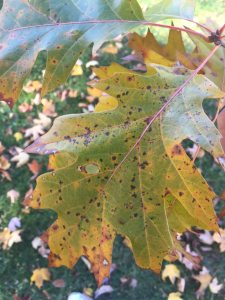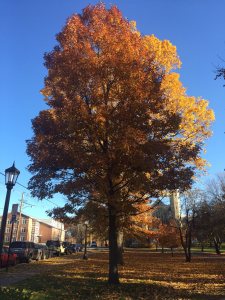Northern Red Oak
Quercus rubra | Family: Fagaceae
Submission: Anabel Carter ‘18
Leaves – deciduous, alternate, 5-8″ inches long, lobes bristle tipped, lobes separated by regular sinuses and glabrous except for the occasional axillary tuft, color is dull green to blue-green on top.
Twigs – stout, red-brown, glabrous.
Buds – ¼” long, ovoid, reddish-brown, bud scales have ciliate margins, has multiple terminal buds.
Fruit – ¾-1″ long, enclosed at base in a thick, saucer-like cap with small scales; matures in 2 growing seasons from late August to late October.
Bark – young bark is smooth, older bark has flat topped ridges with shallow fissures; inner bark is light red.
The northern red oak (Quercus rubra) is a medium sized tree that grows up to 90 feet, is native to North America, and is moderately tolerant. It can be found all throughout the Eastern United States, except for the Southern coastal plain. The northern red oak is the only native oak that extends to Nova Scotia. In areas where this oak grows, the rainfall is usually between 30-80 inches depending on location and snowfall ranges from a tiny amount to 100 inches. The average annual temperatures for its location range from 40 to 60ºF. Northern red oak trees grow best in moist, well drained upland sites such as in coves, deep ravines, and lower and middle slopes.
Northern red oaks are very susceptible to fire damage, as the high heat can kill the cambial tissue at the base of the tree, thus creating an entry point for decay fungi. Northern red oak is also susceptible to the gypsy moth, which is the most destructive defoliating insect that attacks these trees. Another threat to the tree is oak wilt, which is a vascular fungal disease that can kill a tree in the same year that it is infected. Oak wilt is particularly destructive, as it can spread to neighboring trees by root grafting or by sap feeding beetles and/or oak bark beetles.
 Northern red oak is frequently planted as an ornamental due to its bright red fall foliage. The wood from northern red oak trees is commonly used for hardwood lumber to make furniture, veneer, and cabinets. The acorns are an important food source for squirrels, deer, turkey, mice, and other mammals and birds.
Northern red oak is frequently planted as an ornamental due to its bright red fall foliage. The wood from northern red oak trees is commonly used for hardwood lumber to make furniture, veneer, and cabinets. The acorns are an important food source for squirrels, deer, turkey, mice, and other mammals and birds.
References:
Brockman, C.F. 1986. Trees of North America: A Guide to Field Identification. Revised Edition. Western Pub. Co., Inc. 280pp.
Elias, T.S. 1980. The Complete Trees of North America Field Guide and Natural History. Van Nostrand Reinhold Co., N.Y. 948pp.
Harlow, W.M., Harrar, E.S., Hardin, J.W. and White, F.M. 1991. Textbook of Dendrology. McGraw-Hill Inc., N.Y. 501pp.
Petrides, G.A. 1972, A Field Guide to Trees and Shrubs. 2nd edition. Houghton Mifflin Co., Boston. 428pp.
Preston, R.J., Jr. 1989. North American Trees. 4th edition. Iowa State Univ. Press. Ames. 407pp.
Sander, Ivan L. “Quercus Rubra L.” Quercus Rubra L. United States Department of Agriculture, n.d. Web. 03 Nov. 2015
Seiler, John, Edward Jensen, Alex Niemiera, and John Peterson. “Quercus Rubra Fact Sheet.” Quercus Rubra Fact Sheet. Virginia Tech, n.d. Web. 03 Nov. 2015.
Shane, J. 2004. Dendrology Handbook, University of Vermont, Unpublished

